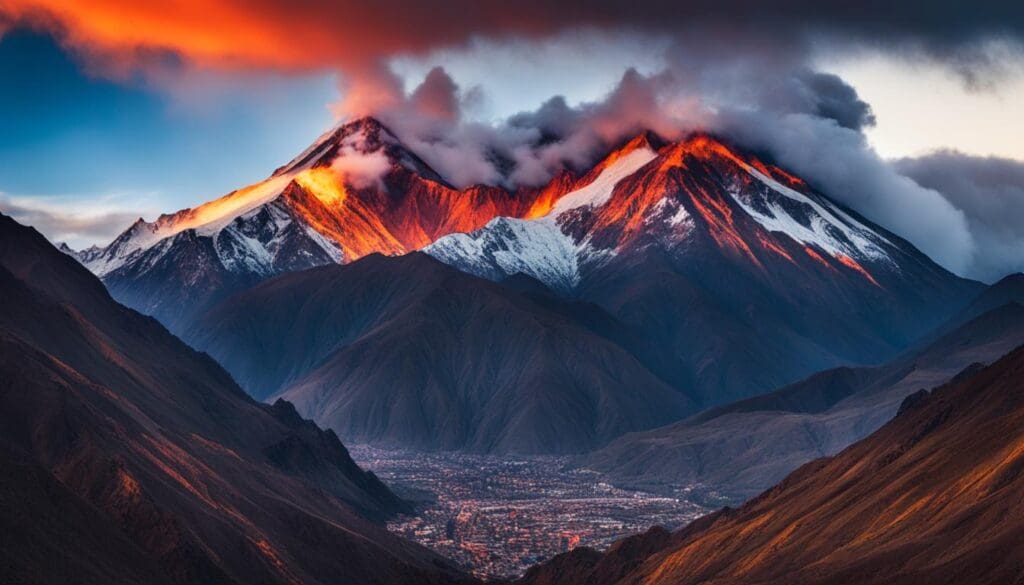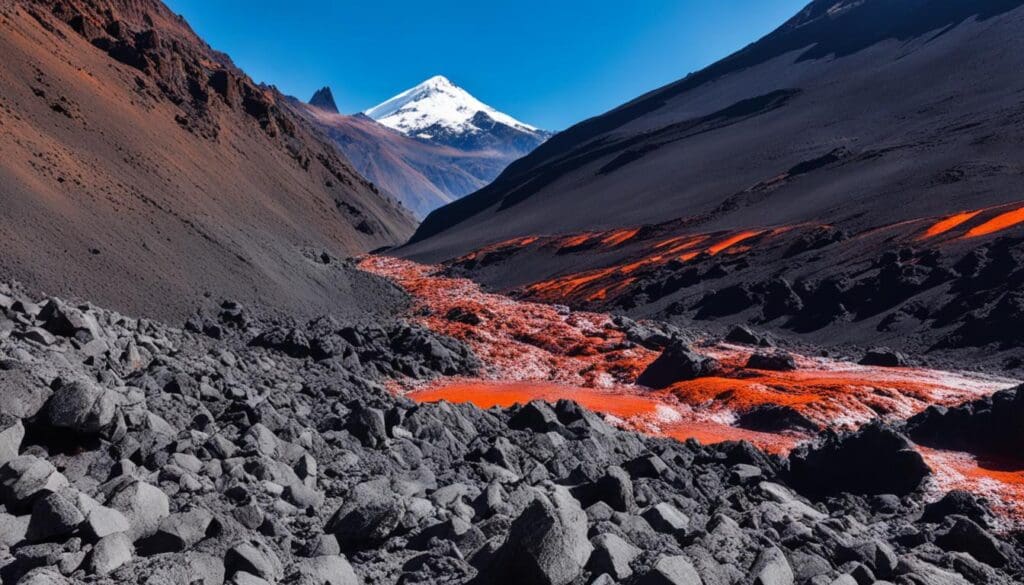Argentina’s landscape is a mix of sharp mountains and the Andes. It offers more than beauty. It’s a goldmine for geology lovers. Experts from top schools are diving into this geological exploration. They are uncovering the volcanic history of Argentina. They’ve found signs of huge ancient eruptions in the Argentina volcanos. This journey is more than a tough walk. It’s a trip back in time. It shows how continents moved and shaped our world.
Dry valleys show high limestone walls. They also reveal shapes that suggest an ocean past, far from today’s beaches. These signs are keys to a big mystery. Solving it could change how we see the South America’s Andean spine. It could explain the creation of its high mountains and deep pits. Dive into Argentina’s explosive and wild geological story.
A Journey Across Varied Argentine Terrains and Their Geological Significance
Argentina’s landscapes show a deep geological significance because of the region’s complex past. These areas tell us about a long-gone supercontinent. We see this in places where parts of what is now North America were once connected to Argentina. The Precordillera is a key example of these huge changes. Once part of North America, it is now in the middle of Argentina. This shows how the land has moved over time.
In Argentina’s dry climate, geological forms like limestone and oceanic crust tell an interesting story. They are clearly visible on any Argentina volcano map. This visibility helps scientists study the area’s geological history. This history goes from the very old Precambrian era to today. The dry area around the Andes volcanoes keeps these stories well preserved. It’s like reading pages from an ancient book.
Students from Brown University are diving into this geological story. They’re using both fieldwork and theory. This approach helps them understand global tectonics. They move through time, putting together Argentina’s geological past. They stand on the ground that tells stories of ancient land movement.
| Geological Feature | Description | Significance |
|---|---|---|
| Precordillera | A fragment of the North American continent in central Argentina | Evidence of historical tectonic land swaps |
| Limestone Formations | Sedimentary rock deposits typical of marine environments | Indicators of past oceanic presence and tectonic activity |
| Oceanic Crust | Slabs of earth’s crust that originated from the ocean floor | Signify the collision and merger of ancient continents |
| Andes Volcanoes | Chain of active and dormant volcanoes along the Andes mountain range | Mark the dynamism of the South American tectonic plate |
The story of geological significance and land movement is highlighted by Argentina’s natural wonders. Ongoing study of these places reveals marks from past events. In this scientific setting, the histories of continents, as told by stones, come together.
The Wonders of Argentina Volcanos: Formations and Fossils
Argentina’s landscape is marked by ancient volcanic processes. It’s filled with rugged lands shaped by intense geologic events. It also has fossils that show life from long ago. The country tells a great story of geology. Columnar joints and pillow basalts show us the fiery past. They tell of events mostly happening under water, a key feature of volcanic activity in Argentina.
The San Juan River valley has big marks on limestone cliffs. These tell of the sea’s old influence on this land. The Precordillera area is full of signs from when it was part of the ocean. Far from today’s seas, it guards this marine history of Argentina’s geology.
The study of fossils, like the paleo-rhea footprints, adds to the excitement. It brings together the study of past life and the fiery earth. In the field, people can find and feel ancient life. This connects us to stories that started millions of years ago.
| Feature | Description | Implications for History |
|---|---|---|
| Columnar Joints | Vertical, hexagonal prisms of rock | Hints at rapid cooling from lava flows, likely in a watery environment |
| Pillow Basalts | Bulbous, pillow-shaped formations | Indicative of submarine volcanic flows |
| Limestone Cliffs | Massive, sedimentary rock formations | Suggest a marine past for now dry regions |
| Fossilized Footprints | Impressions of ancient life forms in rock | Provide a snapshot of past ecosystems and species distribution |
Every rock layer and fossil found tells more of the Argentina volcanos story. They connect learning with the real world. With each discovery, we get closer to understanding Argentina’s fiery core. We also learn about ancient life that once roamed its lands.
The Majestic Andes and the Andean Volcanism
The Andes volcanoes rise high in South America. They are not just big but also important for studying volcanic eruptions in South America. The Llullaillaco volcano is very tall, the second highest active one in the world. It is a key part of the Andean Central Volcanic Zone.
The Llullaillaco volcano has layers from different times. At its base, you can see old volcanic stuff changed by ice ages. On top of that, there are newer rocks that made the volcano taller. These layers tell us about the area’s volcanic past.
The way geology is kept here is amazing. You can see traces of old landslides that go up to 25 kilometers from where they started. They have features like banks and ridges. These marks are clues about past Andes volcanoes activity. They help us understand the history of volcanic eruptions in South America.


The weather and volcanoes work together here. Because it’s so dry and there’s not much erosion, these old geological signs are well-preserved. They give us a clear look into Earth’s ancient changes, especially in the Andean Central Volcanic Zone.
Studying these big volcanoes helps us see how beautiful and powerful nature is. Learning about the Andean volcanoes is key. It helps us understand Earth better. It also prepares people living nearby for any future volcanic eruptions in South America.
Discovery and Dating: The Timeline of Argentine Volcanic Activity
The volcanic history of Argentina has a deep impact on its land. The Llullaillaco volcano is a key site for understanding Pleistocene volcanism. Scientists use radiometric dating to map out its volcanic changes over time.
Early on, glaciers grinded down dacitic materials at Llullaillaco. This shows how tough past climates were. Later, massive lava flows emerged, creating huge Quaternary stratovolcanoes. These big volcanoes show nature’s cycle of building and wrecking.
Geology experts have found an important event in the volcano’s past. It happened after the late Pleistocene, when a big collapse occurred. They used field studies, chemistry, and theories to learn why this happened. This helps us know how argentina volcanos change over time.
The history of these events teaches us a lot about volcanoes in Argentina. It also shows how well the environment has been kept. This good record helps us learn more about volcanic actions. It helps predict what might happen next with volcanoes. So, geochronology makes our understanding of Argentina’s fiery ground stronger.
The Geodynamic Tale of the Southern Puna
The Central Andes’ Southern Puna tells a story of Earth’s restless nature. Its tale is written in the rocks and ash. Here, different forces work together, making a land marked by active changes. This area shows how subduction forces have created a unique scene of volcanic activity in Argentina.
In the high desert of the Southern Puna, one can see signs of deep Earth processes. The Nazca plate moves under the South American plate. This movement creates diverse volcanic activities, studied by scientists.
The earth’s crust shifts and subduction angles change over time. This creates a dynamic setting where history is layered. Through these changing patterns of volcanic activity in Argentina, we learn about the Central Andes.
Studying the Southern Puna reveals deep truths about how continents form and break down. The region shows the power of natural forces in shaping our world. It offers deep insights into both Argentina and Earth’s development.
Argentina’s Volcanoes as Martian Analogues
Scientists study Argentina’s volcanoes, especially Ojos del Salado, to learn about Mars. CU Boulder researchers find this volcano similar to the Martian environment. It has high altitudes and big temperature changes, like on Mars.
Researchers found living microbes in Ojos del Salado despite tough conditions. These microbes show life can survive in harsh places. The minerals there also suggest Mars could have had similar life-supporting conditions.
The extreme conditions on Earth help scientists think about Mars’s past. They use this info to make tools for finding life on Mars.
Argentina’s volcanoes are great for learning about possible life on Mars. They let scientists create Martian-like environments for study. This research helps us think about life beyond Earth and prepares us for space missions.




